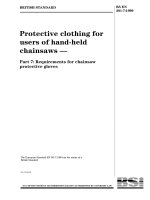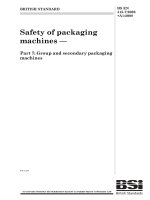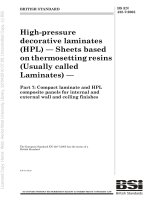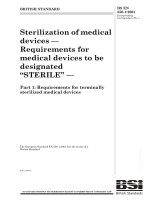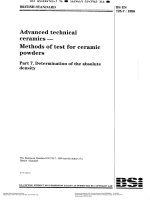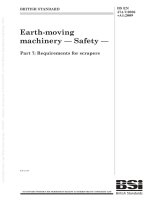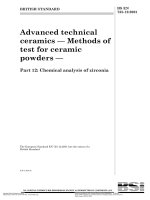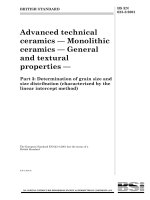Bsi bs en 61131 7 2001
Bạn đang xem bản rút gọn của tài liệu. Xem và tải ngay bản đầy đủ của tài liệu tại đây (620.52 KB, 60 trang )
Licensed Copy: Institute Of Technology Tallaght, Institute of Technology, Wed Jun 20 03:54:19 GMT+00:00 2007, Uncontrolled Copy, (c) BSI
BRITISH STANDARD
Programmable
controllers Ð
Part 7: Fuzzy control programming
The European Standard EN 61131-7:2000 has the status of a
British Standard
ICS 25.040.40; 35.060; 35.240.50
NO COPYING WITHOUT BSI PERMISSION EXCEPT AS PERMITTED BY COPYRIGHT LAW
|
|
|
|
|
|
|
|
|
|
|
|
|
|
|
|
|
|
|
|
|
|
|
|
|
|
|
|
|
|
|
|
|
|
|
|
|
|
|
|
|
|
|
|
|
|
|
|
|
|
|
|
|
|
|
|
|
|
|
|
|
|
|
|
|
|
|
|
|
|
|
|
|
|
|
|
|
|
|
|
|
|
|
|
|
|
|
|
|
|
|
|
|
|
|
|
|
|
|
|
|
|
|
|
|
|
|
|
|
|
|
|
|
|
|
|
|
|
|
|
|
|
|
|
|
|
|
|
|
BS EN
61131-7:2001
IEC
61131-7:2000
Licensed Copy: Institute Of Technology Tallaght, Institute of Technology, Wed Jun 20 03:54:19 GMT+00:00 2007, Uncontrolled Copy, (c) BSI
BS EN 61131-7:2001
National foreword
This British Standard is the official English language version of EN 61131-7:2000. It
is identical with IEC 61311-7:2000.
The UK participation in its preparation was entrusted by Technical Committee
GEL/65, Measurement and control, to Subcommittee GEL/65/2, Elements of systems,
which has the responsibility to:
Ð aid enquirers to understand the text;
Ð present to the responsible international/ European committee any enquiries
on the interpretation, or proposals for change, and keep the UK interests
informed;
Ð monitor related international and European developments and promulgate
them in the UK.
A list of organizations represented on this subcommittee can be obtained on request
to its secretary.
From 1 January 1997, all IEC publications have the number 60000 added to the old
number. For instance, IEC 27-1 has been renumbered as IEC 60027-1. For a period
of time during the change over from one numbering system to the other,
publications may contain identifiers from both systems.
Cross-references
Attention is drawn to the fact that CEN and CENELEC Standards normally include
an annex which lists normative references to international publications with their
corresponding European publications. The British Standards which implement these
international or European publications may be found in the BSI Standards
Catalogue under the section entitled ªInternational Standards Correspondence
Indexº, or by using the ªFindº facility of the BSI Standards Electronic Catalogue.
A British Standard does not purport to include all the necessary provisions of a
contract. Users of British Standards are responsible for their correct application.
Compliance with a British Standard does not of itself confer immunity
from legal obligations.
Summary of pages
This document comprises a front cover, an inside front cover, the EN title page,
pages 2 to 57 and a back cover.
The BSI copyright notice displayed in this document indicates when the document
was last issued.
This British Standard, having
been prepared under the
direction of the Electrotechnical
Sector Committee, was published
under the authority of the
Standards Committee and comes
into effect on 15 April 2001
BSI 04-2001
ISBN 0 580 36843 2
Amendments issued since publication
Amd. No.
Date
Comments
Licensed Copy: Institute Of Technology Tallaght, Institute of Technology, Wed Jun 20 03:54:19 GMT+00:00 2007, Uncontrolled Copy, (c) BSI
EN 61131-7
EUROPEAN STANDARD
NORME EUROPÉENNE
EUROPÄISCHE NORM
December 2000
ICS 35.240.50;25.040.40
English version
Programmable controllers
Part 7: Fuzzy control programming
(IEC 61131-7:2000)
Automates programmables
Partie 7: Programmation en logique floue
(CEI 61131-7:2000)
Speicherprogrammierbare Steuerungen
Teil 7: Fuzzy-Control-Programmierung
(IEC 61131-7:2000)
This European Standard was approved by CENELEC on 2000-11-01. CENELEC members are bound to
comply with the CEN/CENELEC Internal Regulations which stipulate the conditions for giving this European
Standard the status of a national standard without any alteration.
Up-to-date lists and bibliographical references concerning such national standards may be obtained on
application to the Central Secretariat or to any CENELEC member.
This European Standard exists in three official versions (English, French, German). A version in any other
language made by translation under the responsibility of a CENELEC member into its own language and
notified to the Central Secretariat has the same status as the official versions.
CENELEC members are the national electrotechnical committees of Austria, Belgium, Czech Republic,
Denmark, Finland, France, Germany, Greece, Iceland, Ireland, Italy, Luxembourg, Netherlands, Norway,
Portugal, Spain, Sweden, Switzerland and United Kingdom.
CENELEC
European Committee for Electrotechnical Standardization
Comité Européen de Normalisation Electrotechnique
Europäisches Komitee für Elektrotechnische Normung
Central Secretariat: rue de Stassart 35, B - 1050 Brussels
© 2000 CENELEC - All rights of exploitation in any form and by any means reserved worldwide for CENELEC members.
Ref. No. EN 61131-7:2000 E
Licensed Copy: Institute Of Technology Tallaght, Institute of Technology, Wed Jun 20 03:54:19 GMT+00:00 2007, Uncontrolled Copy, (c) BSI
2Page
egaP2
EN 61131−7:2000
Foreword
The text of document 65B/406/FDIS, future edition 1 of IEC 61131-7, prepared by SC 65B, Devices, of
IEC TC 65, Industrial-process measurement and control, was submitted to the IEC-CENELEC parallel
vote and was approved by CENELEC as EN 61131-7 on 2000-11-01.
The following dates were fixed:
– latest date by which the EN has to be implemented
at national level by publication of an identical
national standard or by endorsement
(dop) 2001-08-01
– latest date by which the national standards conflicting
with the EN have to be withdrawn
(dow) 2003-11-01
Annexes designated "normative" are part of the body of the standard.
Annexes designated "informative" are given for information only.
In this standard, annex ZA is normative and annexes A, B, C, D and E are informative.
Annex ZA has been added by CENELEC.
__________
Endorsement notice
The text of the International Standard IEC 61131-7:2000 was approved by CENELEC as a European
Standard without any modification.
__________
Licensed Copy: Institute Of Technology Tallaght, Institute of Technology, Wed Jun 20 03:54:19 GMT+00:00 2007, Uncontrolled Copy, (c) BSI
3 egaP3
Page
EN 61131−7:2000
61131−7:2001
CONTENTS
Page
INTRODUCTION .................................................................................................................... 6
Clause
1
Scope and object ............................................................................................................. 8
2
Normative references ....................................................................................................... 8
3
Definitions........................................................................................................................ 8
4
Integration into the programmable controller ....................................................................10
5
Fuzzy Control Language FCL ..........................................................................................11
6
5.1 Exchange of fuzzy control programs .......................................................................11
5.2 Fuzzy Control Language elements..........................................................................12
5.3 FCL example .........................................................................................................21
5.4 Production rules and keywords of the Fuzzy Control Language (FCL) .....................21
Compliance.....................................................................................................................25
6.1
6.2
Conformance classes of Fuzzy Control Language FCL ...........................................25
Data check list .......................................................................................................27
www.bzfxw.com
Annex A (informative) Theory ...............................................................................................29
A.1
Fuzzy Logic ...................................................................................................................29
A.2
Fuzzy Control ................................................................................................................33
A.3
Performance of Fuzzy control ........................................................................................40
Annex B (informative) Examples ...........................................................................................42
B.1 Pre-control ......................................................................................................................42
B.2 Parameter adaptation of conventional PID controllers ......................................................43
B.3 Direct fuzzy control of a process......................................................................................43
Annex C (informative) Industrial example – Container crane .................................................44
Annex D (informative) Example for using variables in the rule block ......................................54
Annex E (informative) Symbols, abbreviations and synonyms................................................56
Annex ZA (normative) Normative references to international publications with their
corresponding European publications ..............................................................................57
Figure 1 – Example of a fuzzy control Function Block in FBD representation ..........................11
Figure 2 – Data exchange of Programs in Fuzzy Control Language (FCL) ..............................12
Figure 3 – Example of a Function Block interface declaration in ST and FBD languages.........13
Figure 4 – Example of ramp terms .........................................................................................14
Figure 5 – Example of usage of variables for membership functions.......................................14
Figure 6 – Example of singleton terms ...................................................................................15
Figure 7 – Example for fuzzy function block ...........................................................................21
Figure 8 – Levels of conformance ..........................................................................................25
© BSI 04-2001
Licensed Copy: Institute Of Technology Tallaght, Institute of Technology, Wed Jun 20 03:54:19 GMT+00:00 2007, Uncontrolled Copy, (c) BSI
4Page
egaP4
EN 61131−7:2000
61131−7:2001
Figure A.1 – Membership functions of the terms "full legal age" and "adult" ............................30
Figure A.2 – Description of the linguistic variable "Age" by linguistic terms
and their hierarchy on the time scale (age in years) ...............................................................30
Figure A.3 – Commonly used shapes of membership functions ..............................................31
Figure A.4 – Algorithms for implementing operations between two membership functions .......33
Figure A.5 – Structure and functional elements of fuzzy control ..............................................34
Figure A.6 – The principle of fuzzification (as an example) .....................................................34
Figure A.7 – Representation of the knowledge base in linguistic form .....................................35
Figure A.8 – Matrix representation of two variables ................................................................35
Figure A.9 – Elements of inference ........................................................................................36
Figure A.10a – An example showing the principles of aggregation..........................................37
Figure A.10b – The principles of activation (as an example) ...................................................37
Figure A.10c – The principles of accumulation (as an example) .............................................38
Figure A.11a – Methods of defuzzification ..............................................................................38
Figure A.11b – Difference between Left Most Maximum and Right Most Maximum .................39
Figure A.11c – Difference between Centre of Area and Centre of Gravity ...............................39
Figure A.11d – Methods of defuzzification ..............................................................................40
www.bzfxw.com
Figure A.12 – Examples of fuzzy control characteristic curves ................................................41
Figure A.13a – Fuzzy-based controller: Fundamental structure...............................................41
Figure A.13b – Example of a Fuzzy-based controller ..............................................................41
Figure B.1 – Example of a pre-control ....................................................................................42
Figure B.2 – Example of a parameter adaptation....................................................................43
Figure B.3 – Example of a direct fuzzy control........................................................................43
Figure C.1 – Industrial example – Container crane .................................................................44
Figure C.2 – Linguistic variable "Distance" between crane head and target position................45
Figure C.3 – Linguistic variable "Angle" of the container to the crane head .............................45
Figure C.4 – Linguistic variable "Power".................................................................................45
Figure C.5 – Rule base ..........................................................................................................46
Figure C.6 – Fuzzification of the linguistic variable "distance".................................................46
Figure C.7 – Fuzzification of the linguistic variable "angle" .....................................................47
Figure C.8 – Subset of three rules .........................................................................................47
Figure C.9 – Elements of aggregation ....................................................................................47
Figure C.10 – Principles of aggregation .................................................................................48
Figure C.11 – Elements of activation......................................................................................48
Figure C.12 – Principles of activation .....................................................................................49
Figure C.13 – Elements of accumulation ................................................................................49
Figure C.14 – Principles of accumulation ...............................................................................50
Figure C.15 – Defuzzification .................................................................................................51
Figure C.16 – Example in SCL ...............................................................................................52
Figure D.1 – Principle of the controlled system ......................................................................54
© BSI 04-2001
Licensed Copy: Institute Of Technology Tallaght, Institute of Technology, Wed Jun 20 03:54:19 GMT+00:00 2007, Uncontrolled Copy, (c) BSI
5 egaP5
Page
EN 61131−7:2000
61131−7:2001
Figure D.2 – Principle of the fuzzy based control of the oven..................................................54
Figure D.3 – Rule block .........................................................................................................54
Figure D.4 – Example in FCL .................................................................................................55
Table 1 – Defuzzification methods .........................................................................................15
Table 2 – Formulae for defuzzification methods .....................................................................16
Table 3 – Paired algorithms ...................................................................................................17
Table 4 – Activation methods .................................................................................................17
Table 5 – Accumulation methods ...........................................................................................18
Table 6 – Priority of operators................................................................................................18
Table 7 – Reserved keywords for FCL ...................................................................................24
Table 8 – FCL Basic Level language elements (mandatory) ...................................................26
Table 9 – FCL Extension Level language elements (optional) .................................................27
Table 10 – Examples of a list with Open Level language elements .........................................27
Table 11 – Data check list .....................................................................................................28
Table A.1 – Inference steps and commonly used algorithms ..................................................37
Table C.1 – Inference steps and assigned operator................................................................46
Table E.1 – Symbols and abbreviations .................................................................................56
www.bzfxw.com
Table E.2 – Synonyms ...........................................................................................................56
© BSI 04-2001
Licensed Copy: Institute Of Technology Tallaght, Institute of Technology, Wed Jun 20 03:54:19 GMT+00:00 2007, Uncontrolled Copy, (c) BSI
6Page
egaP6
EN 61131−7:2000
61131−7:2001
INTRODUCTION
The theory of fuzzy logic in the application of control is named fuzzy control. Fuzzy control is
emerging as a technology that can enhance the capabilities of industrial automation, and is
suitable for control level tasks generally performed in Programmable Controllers (PC).
Fuzzy control is based upon practical application knowledge represented by so-called linguistic
rule bases, rather than by analytical (either empirical or theoretical) models. Fuzzy control can
be used when there is an expertise that can be expressed in its formalism. That allows to take
available knowledge to improve processes and perform a variety of tasks, for instance
–
control (closed or open loop, single or multi-variable, for linear or non-linear systems),
–
on-line or off-line setting of control systems’ parameters,
–
classification and pattern recognition,
–
real-time decision making (send this product to machine A or B ?),
–
helping operators to make decisions or tune parameters,
–
detection and diagnosis of faults in systems.
Its wide range of applications and natural approach based on human experience makes fuzzy
control a basic tool that should be made available to programmable controller users as a
standard.
Fuzzy control can also, in a straightforward way, be combined with classical control methods.
www.bzfxw.com
The application of fuzzy control can be of advantage in such cases where there is no explicit
process model available, or in which the analytical model is too difficult to evaluate or when the
model is too complicated to evaluate in real time.
Another advantageous feature of fuzzy control is that human experience can be incorporated in
a straightforward way. Also, it is not necessary to model the whole controller with fuzzy control:
sometimes fuzzy control just interpolates between a series of locally linear models, or
dynamically adapts the parameters of a "linear controller", thereby rendering it non-linear, or
alternatively just "zoom in" onto a certain feature of an existing controller that needs to be
improved.
Fuzzy control is a multi-valued control, no longer restricting the values of a control proposition
to "true" or "false". This makes fuzzy control particularly useful to model empirical expertise,
stating which control actions have to be taken under a given set of inputs.
The existing theory and systems already realized in the area of fuzzy control differ widely in
terms of terminology (definitions), features (functionalities) and implementation (tools).
Fuzzy control is used from small and simple applications up to highly sophisticated and
complex projects. To cover all kinds of usage in this part of IEC 61131, the features of a
compliant fuzzy control system are mapped into defined conformance classes.
The basic class defines a minimum set of features which has to be achieved by all compliant
systems. This facilitates the exchange of fuzzy control programs.
© BSI 04-2001
Licensed Copy: Institute Of Technology Tallaght, Institute of Technology, Wed Jun 20 03:54:19 GMT+00:00 2007, Uncontrolled Copy, (c) BSI
7 egaP7
Page
EN 61131−7:2000
61131−7:2001
Optional standard features are defined in the extension class. Fuzzy control programs applying
these features can only be fully ported among systems using the same set of features,
otherwise a partial exchange may be possible only. This standard does not force all compliant
systems to realize all features in the extension class, but it supports the possibility of (partial)
portability and the avoidance of the usage of non-standard features. Therefore, a compliant
system should not offer non-standard features which can be meaningfully realized by using
standard features of the basic class and the extension class.
In order not to exclude systems using their own highly sophisticated features from complying
with this part of IEC 61131 and not to hinder the progress of future development, this standard
permits also additional non-standard features which are not covered by the basic class and the
extension class. However, these features need to be listed in a standard way to ensure that
they are easily recognised as non-standard features.
The portability of fuzzy control applications depends on the different programming systems and
also the charcteristics of the control systems. These dependencies are covered by the data
check list to be delivered by the manufacturer.
www.bzfxw.com
© BSI 04-2001
Licensed Copy: Institute Of Technology Tallaght, Institute of Technology, Wed Jun 20 03:54:19 GMT+00:00 2007, Uncontrolled Copy, (c) BSI
8Page
egaP8
EN 61131−7:2000
61131−7:2001
PROGRAMMABLE CONTROLLERS –
Part 7: Fuzzy control programming
1 Scope and object
This part of IEC 61131 defines a language for the programming of Fuzzy Control applications
used by programmable controllers.
The object of this part of IEC 61131 is to offer the manufacturers and the users a well-defined
common understanding of the basic means to integrate fuzzy control applications in the
Programmable Controller languages according to IEC 61131-3, as well as the possibility to
exchange portable fuzzy control programs among different programming systems.
To achieve this, annex A gives a short introduction to the theory of fuzzy control and fuzzy logic
as far as it is necessary for the understanding of this part of IEC 61131. It may be helpful for
readers of this part of IEC 61131 who are not familiar with fuzzy control theory to read annex A
first.
2 Normative references
www.bzfxw.com
The following normative documents contain provisions which, through reference in this text,
constitute provisions of this part of IEC 61131. For dated references, subsequent amendments
to, or revisions of, any of these publications do not apply. However, parties to agreements
based on this part of IEC 61131 are encouraged to investigate the possibility of applying the
most recent editions of the normative documents indicated below. For undated references, the
latest edition of the normative document referred to applies. Members of IEC and ISO maintain
registers of currently valid International Standards.
IEC 60050-351:1998, International Electrotechnical Vocabulary (IEV) – Part 351: Automatic
control
IEC 61131-3:1993, Programmable controllers – Part 3: Programming languages
3
Definitions
For the purpose of this part of IEC 61131, the following definitions apply.
Further definitions for language elements are given in IEC 61131-3.
NOTE
Terms defined in this clause are italicized where they appear in the text of definitions.
3.1
accumulation
result aggregation
combination of results of linguistic rules in a final result
3.2
aggregation
determination of degree of firing
combination of membership degrees of all individual subconditions in a rule to calculation of
the degree of accomplishment of the condition of a rule
© BSI 04-2001
Licensed Copy: Institute Of Technology Tallaght, Institute of Technology, Wed Jun 20 03:54:19 GMT+00:00 2007, Uncontrolled Copy, (c) BSI
9 egaP9
Page
EN 61131−7:2000
61131−7:2001
3.3
activation
process by which the degree of fulfilment of a condition acts on an output fuzzy set
3.4
conclusion
consequent
output of a linguistic rule, i.e. the actions to be taken (the THEN part of an IF..THEN fuzzy
control rule)
3.5
condition
antecedent
expression comprising subconditions combined with fuzzy operators AND, OR, NOT
3.6
crisp set
special case of a fuzzy set, in which the membership function only takes two values, commonly
defined as 0 and 1
3.7
defuzzification
conversion of a fuzzy set into a numerical value
3.8
degree of membership
membership function value
www.bzfxw.com
3.9
fuzzification
determination of degrees of membership of the crisp input value of the linguistic terms defined
with each input linguistic variable
3.10
fuzzy control
type of control in which the control algorithm is based on fuzzy logic
[IEV 351-17-51, modified]
3.11
fuzzy logic
collection of mathematical theories based on the notion of fuzzy set. Fuzzy logic is a kind of
infinite-valued logic
3.12
fuzzy operator
operator used in fuzzy logic theory
3.13
fuzzy set
A fuzzy set A is defined as the set of ordered pairs (x,mA(x)), where x is an element of the
universe of discourse U and mA(x) is the membership function, that attributes to each x Ỵ U a
real number Î [0,1], describing the degree to which x belongs to the set
© BSI 04-2001
Licensed Copy: Institute Of Technology Tallaght, Institute of Technology, Wed Jun 20 03:54:19 GMT+00:00 2007, Uncontrolled Copy, (c) BSI
Page
01
egaP
10
EN 61131−7:2000
61131−7:2001
3.14
inference
application of linguistic rules on input values in order to generate output values
3.15
linguistic rule
IF-THEN rule with condition and conclusion, one or both linguistic
3.16
linguistic term
in the context of fuzzy control, linguistic terms are defined by fuzzy sets
3.17
linguistic variable
variable that takes values in the range of linguistic terms
3.18
membership function
function which defines the degree of membership over the universe of discourse for a given
fuzzy set
[IEV 351-17-52, modified]
3.19
singleton
fuzzy set whose membership function is equal to one at one point and equal to zero at all other
points
www.bzfxw.com
3.20
subcondition
elementary expression in the form of a variable or as term "linguistic variable IS linguistic term"
3.21
rule base
collection of linguistic rules to attain certain objectives
3.22
weighting factor
value between 0..1, that states the degree of importance, credibility, confidence of a linguistic
rule
4 Integration into the programmable controller
The fuzzy control applications programmed in Fuzzy Control Language FCL according to
clause 5 shall be encapsulated in Function Blocks (or Programs) as defined in IEC 61131-3.
The concept of Function Block Types and Function Block Instances given in IEC 61131-3
applies to this standard.
The Function Block Types defined in Fuzzy Control Language FCL shall specify the input and
output parameters and the fuzzy control specific rules and declarations.
The corresponding Function Block Instances shall contain the specific data of the fuzzy control
applications.
© BSI 04-2001
Licensed Copy: Institute Of Technology Tallaght, Institute of Technology, Wed Jun 20 03:54:19 GMT+00:00 2007, Uncontrolled Copy, (c) BSI
11 egaP
Page
11
EN 61131−7:2000
61131−7:2001
Function Blocks defined in Fuzzy Control Language FCL may be used in Programs and
Function Blocks written in any of the languages of IEC 61131-3, for example, Ladder Diagram,
Instruction List, etc. The data types of the input and output parameters of the Function Block or
Program written in FCL shall match those of the corresponding "calling environment" as
illustrated in figure 1.
Valve_Control_1
Div
T1
in1
Const
in2
Fuzzy _FB
out
Temp
Add
in1
Valve
Var1
P1
in2 out
Valve1
Pressure
IEC
1389/2000
Figure 1 – Example of a fuzzy control Function Block in FBD representation
www.bzfxw.com
In this example, Valve_Control_1 is a user defined Function Block Instance of the Function
Block Type Fuzzy_FB. The Function Block Type Fuzzy_FB may be programmed in Fuzzy
Control Language FCL according to clause 5. The Function Block Fuzzy_FB is used here in a
program or a Function Block which is represented in the graphical language FBD (Function
Block Diagram) of IEC 61131-3.
5 Fuzzy Control Language FCL
5.1 Exchange of fuzzy control programs
The definition of the Fuzzy Control Language FCL is based on the definitions of the
programming languages in IEC 61131-3. The interaction of the fuzzy control algorithm with its
program environment causes it to be "hidden" from the program. The fuzzy control algorithm is
therefore externally represented as a Function Block according to IEC 61131-3. The necessary
elements for describing the internal linguistic parts of the fuzzy control Function Block like
membership functions, rules, operators and methods have to be defined according to this
clause.
The language elements of FCL standardize a common representation for data exchange
among fuzzy control configuration tools of different manufacturers shown in figure 2. Using this
common representation, every manufacturer of programmable controllers may keep his
hardware, software editors and compilers. The manufacturer has only to implement the data
interface into his specific editor. The customer would be able to exchange fuzzy control
projects between different manufacturers.
© BSI 04-2001
Licensed Copy: Institute Of Technology Tallaght, Institute of Technology, Wed Jun 20 03:54:19 GMT+00:00 2007, Uncontrolled Copy, (c) BSI
Page
21
egaP
12
EN 61131−7:2000
61131−7:2001
E d ito r fo r F u zz y
C o n tro l a p p lic a tio n
mManufacturer
a n u fa c tu re rAA
In te rfa c e
E d ito r fo r F u zz y
C o n tro l a p p lic a tio n
m Manufacturer
a n u fa c tu re r BB
FCL
In te rfa c e
In te rfa c e
FCL
In te rfa c e
F C L te x t file
D a ta e x c h a n g e fo rm a t
P ro g ra m m a b le C o n tro lle r
m
a n u fa c tu re r AA
Manufacturer
P ro g ra m m a b le C o n tro lle r
m a n u fa c tu re r B
B
Manufacturer
www.bzfxw.com
IEC
1390/2000
Figure 2 – Data exchange of Programs in Fuzzy Control Language (FCL)
5.2 Fuzzy Control Language elements
Fuzzy control language elements in this subclause are described using examples. The detailed
production rule is given in 5.4.
5.2.1 Function Block interface
According to clause 4, the external view of the fuzzy Function Block requires that the following
standard language elements of IEC 61131-3 be used:
FUNCTION_BLOCK function_block_name
Function block
VAR_INPUT
variable_name: data_type;
....
END_VAR
Input parameter declaration
VAR_OUTPUT
variable_name: data_type;
....
Output parameter declaration
END_VAR
....
VAR
variable_name: data_type;
END_VAR
END_FUNCTION_BLOCK
Local variables
© BSI 04-2001
Licensed Copy: Institute Of Technology Tallaght, Institute of Technology, Wed Jun 20 03:54:19 GMT+00:00 2007, Uncontrolled Copy, (c) BSI
31 egaP
Page
13
EN 61131−7:2000
61131−7:2001
With these language elements, it is possible to describe a function block interface. The
function block interface is defined with parameters which are passed into and out of the
function block. The data types of these parameters shall be defined according to IEC 61131-3.
Figure 3 shows an example of a Function Block declaration in Structured Text (ST) and
Function Block Diagram (FBD) languages.
FUNCTION_BLOCK Fuzzy-FB
VAR_INPUT
Temp: REAL;
Pressure: REAL;
END_VAR
Fuzzy - FB
Temp
VAR_OUTPUT
Valve: REAL;
END_VAR
Pressure
IEC
END_FUNCTION_BLOCK
Structured Text (ST)
Valve
1391/2000
Function Block Diagram (FBD)
Figure 3 – Example of a Function Block interface declaration in ST and FBD languages
5.2.2 Fuzzification
The values of the input variables have to be converted into degrees of membership for the
membership functions defined on the variable. This conversion is described between the
keywords FUZZIFY and END_FUZZIFY.
www.bzfxw.com
FUZZIFY variable_name
TERM term_name:= membership_function;
....
END_FUZZIFY
After the keyword FUZZIFY, the name of a variable which is used for the fuzzification shall be
named. This is the name of a previously defined variable in the VAR_INPUT section. This
linguistic variable shall be described by one or more linguistic terms. The linguistic terms
introduced by the keyword TERM described by membership functions in order to fuzzify the
variable. A membership function is a piece-wise linear function. It is defined by a table of
points.
membership_function ::= (point i), (point j), ...
Every point is a pair of the values of the variable and the membership degree of that value
separated by a comma. The pairs are enclosed in parentheses and separated by commas.
point i ::= value of input i | variable_name of input i , value i of membership degree
With this definition, all simple elements, for example ramp and triangle, may be defined. The
points shall be given in ascending order of variable value. The membership function is linear
between successive points. The degree of membership for each term is therefore calculated
from the crisp input value by the linear interpolation between the two relevant adjacent
membership function points.
The minimum number of points is two. The maximum number is restricted according to
clause 6 conformance classes.
© BSI 04-2001
Example of membership function with three points for linguistic term "warm":
TERM warm:=
(17.5, 0.0) (20.0, 1.0) (22.5, 0.0);
If the value of a linguistic variable is less than the first base point in the look-up table, all
values below the first point in the look-up table shall have the same membership degree as
defined at the first point.
If the value of a linguistic variable is greater than the last base point in the look-up table, all
values greater than the last point in the look-up table shall have the same membership degree
as defined at the last point.
cold
1
warm
FUZZIFY temp;
TERM cold:=
TERM warm:=
END_FUZZIFY
(3, 1) (27, 0);
(3, 0) (27, 1);
0,5
Definition of ramps:
0
Licensed Copy: Institute Of Technology Tallaght, Institute of Technology, Wed Jun 20 03:54:19 GMT+00:00 2007, Uncontrolled Copy, (c) BSI
Page
41
egaP
14
EN 61131−7:2000
61131−7:2001
0
10
20
30
temp
IEC
1392/2000
Figure 4 – Example of ramp terms
NOTE The data type of the points of membership functions is not defined. The manufacturer must provide a
compiler that accommodates any necessary conversion.
www.bzfxw.com
In order to adapt the fuzzy control application on-line, the base points in the membership
functions can be modified. This may be done using variables which are input to the function
block. These variables have to be declared in the VAR_INPUT section of the function block. An
example for the use of variables for the definition of the points for the membership functions is
given in figure 5.
NOTE
The values of membership function points at runtime may be out of sequence.
VAR_INPUT
temp: REAL;
(* this input shall be fuzzified *)
pressure: REAL;
(* this input shall be fuzzified *)
bp_warm1, bp_warm2: REAL;
(* these inputs are for on-line adaptation *)
END_VAR
FUZZIFY temp
TERM warm:= (bp_warm1, 0.0), (21.0, 1.0), (bp_warm2, 0.0);
..
END_FUZZIFY
IEC
1393/2000
Figure 5 – Example of usage of variables for membership functions
5.2.3 Defuzzification
A linguistic variable for an output variable has to be converted into a value. This conversion is
described between the keywords DEFUZZIFY and END_DEFUZZIFY.
After the keyword DEFUZZIFY, the variable which is used for the defuzzification shall be
named. This is the name of a previous defined variable in the VAR_OUTPUT section.
© BSI 04-2001
DEFUZZIFY variable_name
RANGE(min..max);
TERM term_name:= membership_function;
defuzzification_method;
default_value;
END_DEFUZZIFY
The definition of linguistic terms is given in 5.2.2.
Singletons are special membership functions used for outputs in order to simplify the
defuzzification. They are described only by a single value for the linguistic term. In figure 6,
examples of terms are given.
drainage
Definition of singletons:
closed
inlet
0 0,5 1 1,5
Licensed Copy: Institute Of Technology Tallaght, Institute of Technology, Wed Jun 20 03:54:19 GMT+00:00 2007, Uncontrolled Copy, (c) BSI
51 egaP
Page
15
EN 61131−7:2000
61131−7:2001
DEFUZZIFY valve
RANGE(–100,100);
TERM drainage := –100;
TERM closed := 0;
TERM inlet
:= 100;
END_DEFUZZIFY
-200
-100
0
valve
100
200
IEC
Figure 6 – Example of singleton terms
www.bzfxw.com
The defuzzification method shall be defined by the language element METHOD.
METHOD: defuzzification_method;
The following defuzzification methods are allowed (see tables 1 and 2).
Table 1 – Defuzzification methods
Keyword
Explanation
CoG
Centre of Gravity (note 1)
CoGS
Centre of Gravity for Singletons
CoA
Centre of Area (notes 2 and 3)
LM
Left Most Maximum (note 4)
RM
Right Most Maximum (note 4)
NOTE 1
Centre of Gravity is equivalent to Centroid of Area.
NOTE 2
Centre of Area is equvalent to Bisector of Area.
NOTE 3
CoA is not applicable if singletons are used.
NOTE 4
LM and RM defuzzification methods are asymmetrical about zero.
© BSI 04-2001
1394/2000
Licensed Copy: Institute Of Technology Tallaght, Institute of Technology, Wed Jun 20 03:54:19 GMT+00:00 2007, Uncontrolled Copy, (c) BSI
Page
61
egaP
16
EN 61131−7:2000
61131−7:2001
Table 2 – Formulae for defuzzification methods
Max
COG
U =
òu
m (u) du
Min
Max
ò m (u) du
Min
p
COGS
U =
å [u
i
m i]
i= 1
p
å [m ]
i
i= 1
u'
COA
U = u' ,
ò
m u du =
Min
Max
ò m u du
u'
RM
U = sup u ' , m u ' =
LM
U = inf u ' , m u ' =
m u
sup
u Ỵ Min , Max
[
]
m u
inf
u Ỵ Min , Max
[
]
where
U
is the result of defuzzification;
u
is the output variable;
p
is the number of singletons;
www.bzfxw.com
m
is the membership function of accumulated fuzzy sets;
i
is the index;
Min is the minimum value for defuzzification defined in RANGE.
In the case of singletons, Min = –infinity;
Max is the maximum value for defuzzification defined in RANGE.
In the case of singletons, Max = +infinity;
sup is the largest value;
inf
is the smallest value.
If the degree of membership is 0 for all linguistic terms of an output variable, that means: no
rule for this variable is active. In that case, the defuzzification is not able to generate a valid
output. Therefore, it is allowed to define a default value for the output. This default value is the
value for the output variable only in the case when no rule has fired.
DEFAULT:= value | NC;
After the keyword DEFAULT, the value shall be specified. Otherwise, the keyword NC (no
change) shall be specified to indicate that the output shall remain unchanged if no rule has
fired.
The range is a specification of a minimum value and a maximum value separated by two
points.
RANGE:= (minimum value .. maximum value);
The RANGE is used for limiting each membership function to the range of each output variable.
If singletons are used for output membership functions, the RANGE has no effect.
If there is no range defined the default range shall be the range of the data type of the variable
specified in IEC 61131-3.
© BSI 04-2001
Licensed Copy: Institute Of Technology Tallaght, Institute of Technology, Wed Jun 20 03:54:19 GMT+00:00 2007, Uncontrolled Copy, (c) BSI
71 egaP
Page
17
EN 61131−7:2000
61131−7:2001
5.2.4 Rule block
The inference of the fuzzy algorithm shall be defined in one or more rule blocks. For proper
handling and to cater for the possibility of splitting the rule base into different modules, the use
of several rule blocks is allowed. Each rule block shall have a unique name.
Rules shall be defined between the keywords RULEBLOCK and END_RULEBLOCK.
RULEBLOCK ruleblock_name
operator_definition;
[activation_method;]
accumulation_method;
rules;
END_RULEBLOCK
The fuzzy operators are used inside the rule block.
operator_definition ::= operator: algorithm
To fulfill de Morgan’s Law, the algorithms for operators AND and OR shall be used pair-wise;
for example MAX shall be used for OR if MIN is used for AND.
Table 3 – Paired algorithms
operator OR
operator AND
keyword for
Algorithm
www.bzfxw.com
keyword for
Algorithm
Algorithm
MAX
Max (m 1 (x), m 2 (x))
ASUM
BSUM
Algorithm
MIN
Min(m 1 (x), m 2 (x))
m 1 (x)+m 2 (x) – m 1 (x) m 2 (x)
PROD
m 1 (x) m 2 (x)
Min(1, m 1 (x) + m 2 (x))
BDIF
Max (0, m 1 (x) + m 2 (x) -1)
An example of rule blocks:
RULEBLOCK first
AND: MIN;
..
END_RULEBLOCK
RULEBLOCK second
AND: PROD;
..
END_RULEBLOCK
The following language element defines the method of the activation:
ACT: activation_method;
The following activation methods are may be used (see table 4):
Table 4 – Activation methods
Name
Keyword
Algorithm
Product
PROD
m 1 (x) m 2 (x)
Minimum
MIN
Min(m 1 (x), m 2 (x))
NOTE
The activation method is not relevant for singletons.
© BSI 04-2001
Licensed Copy: Institute Of Technology Tallaght, Institute of Technology, Wed Jun 20 03:54:19 GMT+00:00 2007, Uncontrolled Copy, (c) BSI
Page
81
egaP
18
EN 61131−7:2000
61131−7:2001
The following language element defines the method of the accumulation:
ACCU: accumulation_method;
The following accumulation methods may be used (see table 5):
Table 5 – Accumulation methods
Name
Keyword
Formula
Maximum
MAX
MAX (m 1 (x), m 2 (x))
Bounded sum
BSUM
MIN (1, m 1 (x) + m 2 (x))
Normalized sum
NSUM
m 1 (x) + m 2 (x)
_________________________________
MAX (1, MAXx’ỴX (m 1 (x’) + m 2 (x’)))
The inputs of a rule block are linguistic variables with a set of linguistic terms. Each term has a
degree of membership assigned to it.
The rules are defined inside the rule block. Each begins with the keyword RULE followed by a
name for the rule and shall be concluded by a semicolon. Each rule has a unique number
inside the rule block.
RULE numbers: IF condition THEN conclusion [ WITH weighting factor];
www.bzfxw.com
The rule itself shall begin with the keyword IF followed by the condition. After the condition, the
conclusion follows, beginning with the keyword THEN.
It is allowed to combine several subconditions and input variables in one rule. The purpose of
variables is to permit fuzzy degrees of membership to be imported into the fuzzy Function
Block. All of them shall be defined between the keywords IF and THEN, and combined by the
operators with the keywords AND, OR or NOT.
The priority of the operator (see table 6) is handled according to Boolean algebra given in
table 3.
Table 6 – Priority of operators
Priority
operator
1
( ) parenthesis
2
NOT
3
AND
4
OR
Simplified example for a rule:
RULE 1: IF subcondition1 AND variable1 OR variable2 THEN conclusion;
In the Basic Level of conformance, the OR operation may be implemented by defining two
rules:
RULE 3: IF subcondition 1 OR subcondition 2 THEN conclusion;
replaced by:
RULE 3a: IF condition 1 THEN conclusion;
RULE 3b: IF condition 2 THEN conclusion;
© BSI 04-2001
